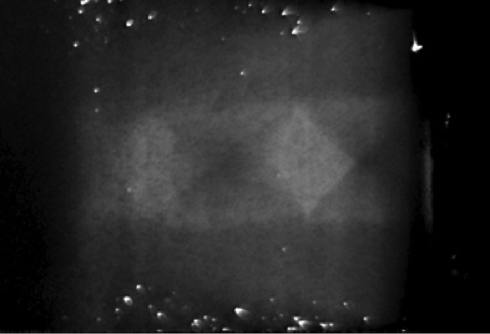Technologies
Filtered Rayleigh Scattering
Filtered Rayleigh scattering (FRS) is a technique for measuring gas flow properties, such as velocity, temperature, and/or pressure, that does not require seeding of the flow. It utilizes a narrow linewidth laser to produce Rayleigh-scattered light from the flow, and the collected light is filtered by a cell containing a molecular vapor, for example, iodine, before detection. Variations in the Rayleigh-Brillouin lineshape profile from the gas being measured cause variations in the detected light intensity that depend on the property or properties of interest.
A schematic of a FRS system is illustrated in Figure 1. The flow field is illuminated using a laser sheet from a frequency-doubled, injection-seeded Nd:YAG laser, resulting in Rayleigh-Brillouin scattering (RBS), which is passed through an iodine filter placed in front of the camera (see Figure 1). The filter is a glass cylindrical cell containing a small amount of iodine vapor with a known absorption profile in the frequency region of interest. When the laser wavelength is tuned to an iodine resonance, the iodine cell absorbs stray laser light scattered from the walls and windows, but the RBS light is thermally broadened due to the kinetic motion of the molecules, and thus a portion of it gets transmitted (see Figure 2). Thus, the signal measured by the camera represents the gas phase RBS, while stray laser light from surfaces gets blocked. Broadening of the RBS spectrum due to either thermal or collisional effects increases the signal, and can be used for determining temperature or pressure, respectively. Furthermore, bulk motion of the gas will cause a Doppler shift of the RBS spectrum, which results in a change in cell transmission that can be useful for measuring the velocity.


FRS has been shown to be a useful tool for flow diagnostics. Measurements can be made with a high-power, short-pulse-duration laser that can freeze a flow field in time and capture quantitative images of flow structures that can be spatially- and temporally-resolved using high-frame-rate cameras. These characteristics are particularly useful in supersonic and hypersonic flows, where the shear layers and shock waves are associated with high gradients and fluctuations.
FRS was first demonstrated in 1990 at Princeton and used for imaging turbulent structures with an injection-seeded, frequency-doubled Nd:YAG laser and an iodine absorption filter.[i] Shortly thereafter, it was demonstrated that by tuning the laser, simultaneous measurements of temperature, density, and velocity could be achieved in a supersonic free jet.[ii] For accurate measurements of these parameters, the iodine filter characteristics were carefully studied and a model was developed for the iodine line shape profile.[iii] The ability of the filter to remove background scattering from windows and walls was recognized early. This was particularly useful for high-speed, wall-bounded flows where the Doppler shift associated with the velocity moves the Rayleigh scattering spectrum (from the flow) out of the filter extinction band, while scattering from windows and walls is still suppressed. This aspect, in part, led to the first real-time imaging of shock-wave/boundary layer interactions in supersonic flows.[iv] Furthermore, an attractive feature of this technique is the use of high-sensitivity cameras as detectors, which permits instantaneous, spatially-correlated, 2-D images with high spatial resolution as determined by the detector resolution. Recent work by MetroLaser has produced an FRS system that was used for measuring density in a supersonic jet.[v] Figure 3 shows an FRS image of shock diamonds observed in the jet.

